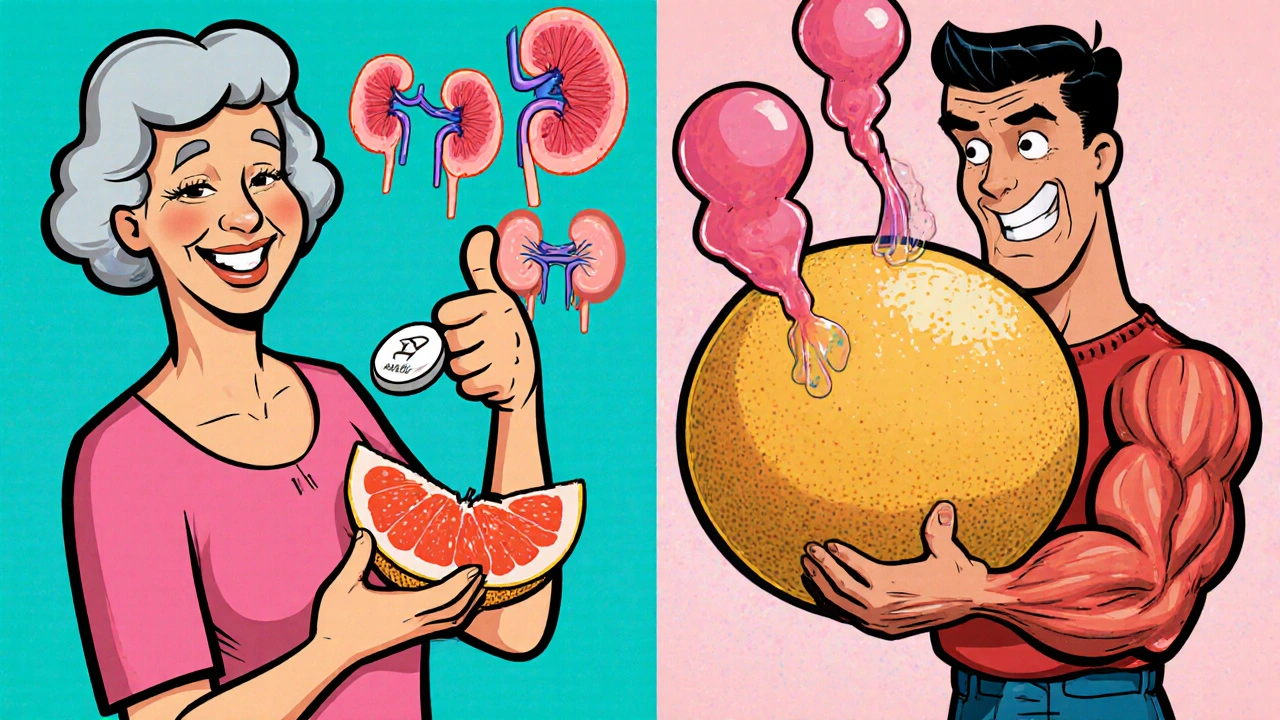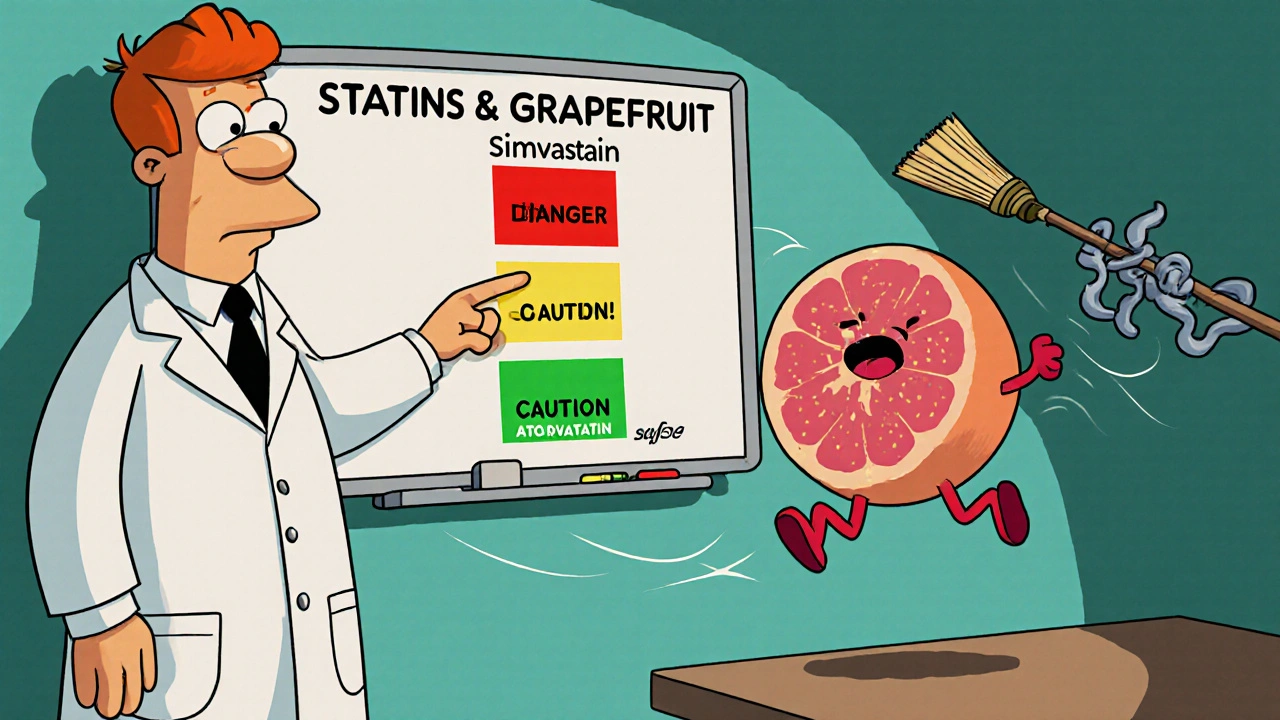Grapefruit and Statins: Safe Dose Thresholds and Real Risks

Grapefruit-Statins Interaction Calculator
This tool helps you assess your risk of dangerous interactions between grapefruit and statin medications. Results are based on medical research from the FDA and peer-reviewed studies.
Your Statin Information
Your Grapefruit Consumption
oz
Many people take statins to lower cholesterol and protect their heart. But if you love grapefruit, you might be wondering: how much is too much? One glass of juice? Half a fruit? Is it safe at all? The answer isn’t simple - and it depends on which statin you’re taking, how much grapefruit you eat, and even your body’s unique biology.
Why Grapefruit and Statins Don’t Mix
Grapefruit doesn’t just taste tart - it’s chemically powerful. Inside grapefruit, especially the juice and peel, are compounds called furanocoumarins. These block an enzyme in your gut called CYP3A4. That enzyme normally breaks down certain drugs before they enter your bloodstream. When it’s shut down, those drugs build up - sometimes dangerously so. For statins, that means higher blood levels. And higher levels mean higher risk of muscle damage, including a rare but serious condition called rhabdomyolysis. This can lead to kidney failure. It’s not common, but it’s real. And it’s why doctors warn about grapefruit with certain statins.Which Statins Are Risky?
Not all statins react the same way. The interaction only matters for those that rely heavily on CYP3A4 to get broken down. Here’s the split:- High risk: Simvastatin (Zocor), lovastatin (Mevacor), atorvastatin (Lipitor)
- Low or no risk: Pravastatin (Pravachol), rosuvastatin (Crestor), fluvastatin (Lescol), pitavastatin (Livalo)
How Much Grapefruit Is Dangerous?
There’s no universal “safe” amount - but there are clear thresholds based on research. Studies show that as little as 200-250 ml (about 8 oz) of grapefruit juice can significantly increase blood levels of simvastatin. One 2006 study found this amount tripled or even quadrupled the drug’s concentration in the blood. That’s not a small change - it’s enough to raise the risk of muscle damage. The FDA considers 1.2 liters per day (five 8-oz glasses) to be “excessive” and clearly dangerous with high-risk statins. But here’s the catch: you don’t need to drink that much to be at risk. Even one glass a day, consistently, can push drug levels into danger zones - especially if you’re older, taking other medications, or have genetic variations that make your CYP3A4 enzyme more sensitive. A 2012 study in the Canadian Medical Association Journal found that after drinking one glass of grapefruit juice, some people had up to 8 times more drug in their blood than others. Genetics matter.
What About Half a Grapefruit?
If you’re not drinking juice but eating the fruit, you’re likely consuming less of the active compounds. One half of a grapefruit contains roughly the same amount of furanocoumarins as 8 oz of juice. So, the same rules apply. Some experts, like Dr. Stanley Hazen at Cleveland Clinic, say that occasional consumption - say, half a grapefruit or one glass of juice - is likely fine for most people on low or moderate doses of statins. But “occasional” means not daily. Daily intake, even in small amounts, adds up.Dose Matters Too
It’s not just about grapefruit - it’s about how much statin you’re taking. A 2004 study showed that taking 60 mg of simvastatin with 400 ml of grapefruit juice three times a day led to a 700% increase in drug exposure. That’s extreme. But even at normal doses - say, 20 mg simvastatin - daily grapefruit juice can still double your drug levels. If you’re on 80 mg of simvastatin (the highest dose), the European Medicines Agency recommends avoiding grapefruit entirely. The risk isn’t worth it.Timing Might Help - But Not Much
Some older advice suggested taking your statin at night and grapefruit in the morning, hoping the enzyme would recover by bedtime. But research shows that’s not reliable. CYP3A4 inhibition lasts for 24-72 hours after grapefruit is consumed. The enzyme doesn’t just bounce back overnight. Once it’s blocked, it takes days to regenerate. So timing won’t save you if you’re consuming grapefruit daily. The only real solution is to avoid it or switch statins.
What Should You Do?
If you’re on a high-risk statin and love grapefruit, here’s your action plan:- Check your statin name. If it’s simvastatin, lovastatin, or atorvastatin, proceed with caution.
- Track your intake. Are you having juice every morning? Half a grapefruit daily? That’s a problem.
- Ask your doctor about alternatives. Switching to pravastatin, rosuvastatin, or fluvastatin lets you keep eating grapefruit. These statins don’t interact.
- Monitor your body. If you start feeling unexplained muscle pain, weakness, or notice dark urine, stop grapefruit immediately and call your doctor. These are warning signs of muscle breakdown.